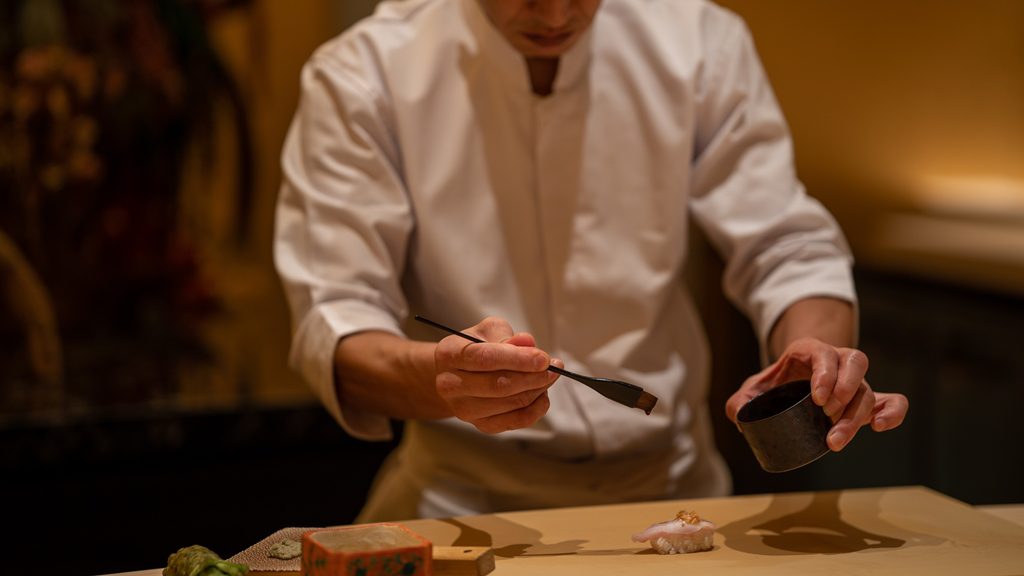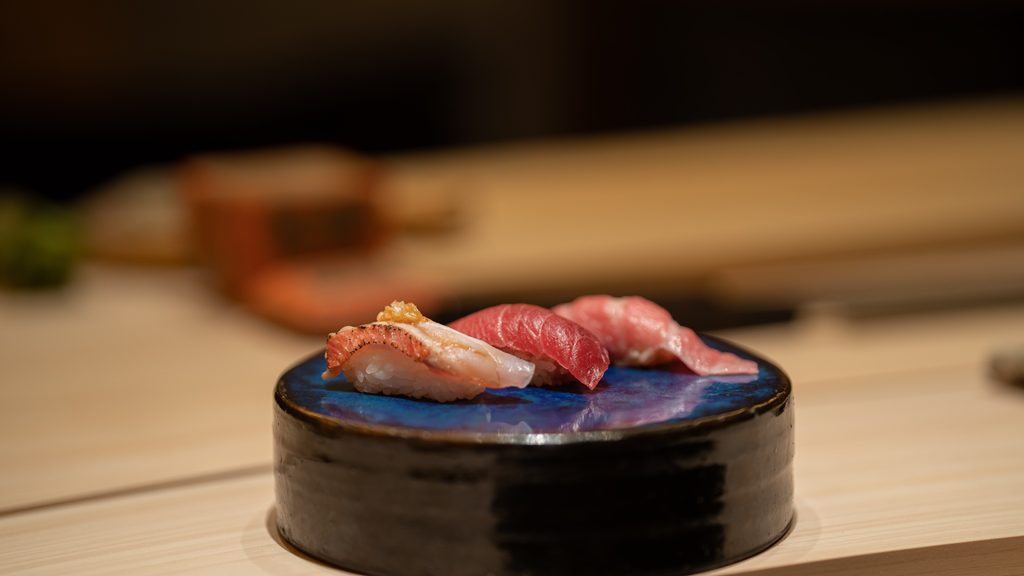 Maetomo Japanese Cuisine Kaiseki & Sushi Transports You to Japan with Washoku
Maetomo Japanese Cuisine Kaiseki & Sushi Transports You to Japan with Washoku
CONTENT: Adriel Yong
As you enter Maetomo Japanese Cuisine Kaiseki & Sushi, it almost feels like you are teleported to Japan with the immaculate interior design reflecting different seasons in Japan. The newly refurbished sushi counter was formerly a cocktail bar and the arrangement was derived from the seating style of a traditional Japanese tearoom. All diners get to see the Chef up close in action as they carefully execute each dish, making this the front row seats to an exciting performance. Through the latest menu, Chef Maetomo hopes to provide a modern twist on fine-dining dishes in Japanese cuisine.
Our first course was Monkfish liver cooked with sake, soy sauce and ginger. This was a dish that is reminiscent of foie gras but was surprisingly rich without being overpowering. The richness of the liver was also balanced by the refreshing ginger sauce. Health-conscious diners will be glad to know that this is significantly lower in fat compared to foie gras.
Next, we had a Female Snow Crab from Hyogo, which is only in season for two months. The chefs had painstakingly scooped out the meat from the crab and layered it on the gorgeous eggs and roe of the crab. Each spoonful is full of fresh and sweet crab meat as well as the rich and flavourful crab roe.
We were served three kinds of ‘Authentic Sashimi’. Amberjack from Kochi which had a clean taste and tender flesh, the prized Bluefin tuna belly (Chutoro) and FATTY bluefin tuna belly (Otoro), both from Aomori.
‘Modern Sashimi’ was interesting as it resembled a masterful artpiece that combined the beautiful colours of the Ochetra caviar with Bafun Uni and gold flakes, on top of thin slices of Hyogo flounder.
Japanese Tamago is not your ordinary egg. The Homemade Japanese omelet at Maetomo takes it a step further by using Oita-produced eggs which ave dense yolks and tender whites. This makes the omelet a lot richer than they already typically are in flavours and sweetness.

Our Edomae Sushi course featured six different varieties of sushi. Gizzard Shad from Kumamoto, Yellow Tail from Hokkaido, Ark Shell from Miyagi, Pacific Saury from Hokkaido topped w ginger, Hamaguri Hard Shelled Clams from Shiba and Soft grilled gold eyes snapper from Shizuoka. Our favorite was the incredibly flavorful and tender Hamaguri clams. This was cooked with sake, mirin and soy sauce till “medium rare”, giving it a range of textures on the outside and inside.
One of the few cooked items on the menu was the Binchotan grilled Tail fish from Kyoto. The strong charcoal flavours complimented the firmness of the fresh fish. This was served with a thin cracker of baby sardines and a slice of ginger bud.
The Japanese Steamed Black Abalone from Yamaguchi was a stunning dish both visually and gastronomically. The abalone is steamed with radish and chicken skin for four hours before being served with an abalone liver sauce made with the liver and the jus from steaming. This was an incredibly rich and formidable combination of textures.
Along the way, we also got to try a stunning Sea Urchin and Salmon Roe Sushi Bowl from Hokkaido, fresh Japanese Tiger Prawns from Kumamoto.

Our final sushi item was the Osaka Sushi featuring Pickled mackerel from Aomori and Unagi from Setouchi. To make the perfectly squared sushi, the Chefs had to press pieces of fish on top of the rice for several hours. Chef Miyata mastered the art of. Osaka Sushi at a 370 year old restaurant in Osaka and has been serving customers with both Edomae Sushi and Osaka Sushi since.
To wash down the sumptuous feast of the Japanese sea, we had a seasonal clear soup that had fishballs made from Kensaki Ika (Red Squid) from Nagasaki, which is sweeter than the typical squid. The soup also had a grilled eggplant from Miyagi which gave it subtle smoky flavours. The robust flavours of the soup were further enhanced by the addition of bonito and tuna flakes.
We ended our meal on a sweet note with the prized Japanese fruits that are known for their impeccable sweetness and are often gifted as a sign of respect. The Muskmelon from Shizuoka was the sweetest of the three, while the Persimmon from Nara and Pear from Shimane were nonetheless refreshing and crunchy in texture.
The Omakese Sushi course is priced at S$300++ or S$380++. There is also a S$75++ corkage charge per bottle and corkage waiver 1 for 1.
Maetomo Japanese cuisine Kaiseki & Sushi
39 Scotts Rd, #01-01, Sheraton Towers Hotel, Singapore 228230
Operating Hours: Monday- Sunday 6:00PM-10:30PM
Website





Leave a Comment